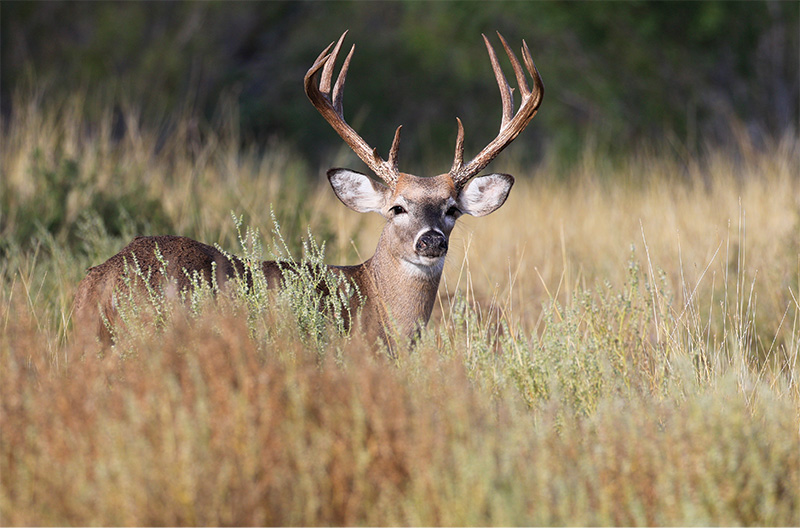Food Plots in Iowa: Whitetails 365

Food Plots in Iowa
One of the best things about living in Iowa is the wildlife we get to see every day. I think just about every Iowan can appreciate the opportunity to watch wildlife in their backyard, from their treestand, or their blind. We have several different species of animals. Northern Iowa has more pheasants than other parts of the state, while the Southern parts hold more deer. There are pockets of habitat that support several different species of game as well as songbirds, and small mammals. You don’t have to be a hunter to appreciate the wildlife around you, and by incorporating food plots in Iowa you can attract and hold multiple species of wildlife on your property. Why not try and attract several different types of wildlife with one food plot?
Choosing the Right Mix
A multi-species food plot in Iowa works best when you provide a combination of food sources and cover. I like to plant something tall like sorghum or corn—anything that reaches chest height or taller. These crops provide food and essential cover for birds and other small game. Even planting timothy or other tall grasses can offer great nesting and hiding areas for pheasants and quail.
When it comes to deer in the fall, when acorns are depleted and natural browse is sparse, this food plot becomes their destination. It acts as a powerful attractant, drawing them from considerable distances. You can use legumes, brassicas, grains, or a specific blend tailored to your land, to provide essential nutrients and calories for their well-being.
It’s not merely about satiating their appetites. It’s about promoting their overall health. By planting multiple species in one place, you can help promote antler development, fawn growth, and general vitality. A healthy deer population translates to a stable deer population. It’s not limited to deer. Turkeys, pheasants, and rabbits are all attracted to these plots. We’re providing brood habitat, seed sources, and cover, everything they require to thrive.
Blending different plants together can make your food plot more effective. Consider planting a mix that includes grains like sorghum or corn alongside legumes like clover or alfalfa. Clover is an excellent choice because it provides high-quality forage for deer while also attracting pollinators and insects that benefit turkey and other game birds. Brassicas, such as turnips and radishes, offer late-season food when other sources become scarce, making them an excellent addition for sustaining wildlife through the winter.
The combination of millet, sorghum, and sunflowers has a powerful trifecta of food and habitat for several different wildlife. The selection of what you’re going to plant should be your first step in attracting the wildlife you want. Doves, for example, prefer seeds like millet, sorghum, and sunflower. This can make for a fun September once the dove season opens. Turkeys and deer are drawn to the seed heads of millet and sorghum. The deer will start hitting the sorghum hard right before bow season opens up, but this can help you pattern a certain buck and make a plan for opening day.
When it comes to turkey, they like the option of clover or alfalfa with some grains nearby. By planting multiple species, you will promote a habitat for various insects for the turkey and birds to eat as well. as well as the insects attracted to sunflowers. These plants provide essential habitat features for a variety of other species, including songbirds, quail, and rabbits, and depending on the size of your food plot, you might even find a bedded deer. Songbirds, such as finches and sparrows, benefit from the abundant seed sources, while quail and other game birds will start frequenting your fields eating seed heads. Remember when you first started getting into hunting? I’ll bet you went rabbit hunting. When you plant these food plots, rabbits will use the food plot for shelter.
Size and Location Matter
The size of your food plot will determine how much of an impact it has on local wildlife. If you have a larger area, you can plant different sections with a variety of crops to cater to multiple species. For example, you might plant corn or sorghum along the edges for cover, a strip of clover in the center for grazing, and some brassicas on the outer edges to provide late-season food.
If you’re working with a smaller plot, you can still make a big difference. A simple mix of clover and sorghum can provide food and shelter in even a quarter-acre plot. Location is also important—plant your food plot near timber, water sources, or any place wildlife frequent to maximize it.
Getting Started
The foundation of a productive food plot lies in creating a good seedbed to get good soil-to-seed contact. You can do this through tilling, discing, or harrowing, depending on what equipment you have available.
You can also use several different pieces of equipment to accomplish it. Traditionally, we would use a tractor, plow, disc, and harrow, but now we have several different options. You can find smaller equipment made for smaller categories of compact tractors. You also now, more than ever, have a variety of attachments for your four-wheeler and ATV/UTV. If you are willing to put in the work and don’t want to have a huge food plot, you can use some spray to kill everything standing and then either plant directly into it, or use a hand-held garden tiller to break the soil.
When it comes to planting, small seeds like millet, require shallow planting, so don’t bury it too deep. Sorghum can be planted a little deeper and can be broadcast, planted, or drilled. Sunflowers can benefit from planting the seeds in mounds.
Several key factors contribute to the success of a wildlife food plot. Soil fertility, determined through soil testing, should be addressed to make sure your soil has the right nutrients. You might need to add some amendments to get it up to par. Weed control, both before and after planting will help you get your food plot off to a good start.
If you are serious about managing your property, about attracting and maintaining wildlife, you can really amp up the quantity and quality of wildlife on your land. It requires commitment, but the rewards are worth it. No matter what, a multispecies food plot can significantly improve the wildlife you see in Iowa. By prioritizing seedbed preparation and selecting plant species, landowners can create a valuable food plot for wildlife conservation.
Next month, we will continue our discussion on improving wildlife habitat on your property with some tips for a do-it-yourself water source.
By Aaron McKinney
June 2025
Here you can find an article from this month to look at –
Also check out last month’s issue of Whitetails 365 –
Please also come look at our other websites


